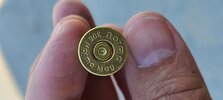Pheroze
AH ambassador
Hey guys I am wondering if you would mind weighing in on this load development.
I am trying to load CEB Maximus 150gr for my 308 Norma Mag. CEB does not have data but from other reloading manuals I expected 3250 fps max.
I am experimenting with using the ladder method - I loaded .3gr from a starting load based on other 150gr bullets in a manual. I have 23 loaded cartridges up to a listed max load for Woodleighs. I am only half way up, at #13, and I am exceeding the max. Also, I can't discern a plateau so I am a little stuck. What I have noticed are three distinct groups on my target but all bullets landed very close. I can now see a ring on the fired brass but the primer looks pretty standard.
I am thinking #10 is what I should try a 3 shot group with next time. That is 74.2gr RL-19. But, am I short changing myself and should I keep climbing the ladder?
Sorry for the long post. I tried to group the pictures identifying the #












The crazy SD is because I recorded all shots in on list.
The bolt is not hard to lift.
Any ideas would be appreciated. To be honest, I think any would work because the bullet just seems to be very accurate regardless of load.
I am trying to load CEB Maximus 150gr for my 308 Norma Mag. CEB does not have data but from other reloading manuals I expected 3250 fps max.
I am experimenting with using the ladder method - I loaded .3gr from a starting load based on other 150gr bullets in a manual. I have 23 loaded cartridges up to a listed max load for Woodleighs. I am only half way up, at #13, and I am exceeding the max. Also, I can't discern a plateau so I am a little stuck. What I have noticed are three distinct groups on my target but all bullets landed very close. I can now see a ring on the fired brass but the primer looks pretty standard.
I am thinking #10 is what I should try a 3 shot group with next time. That is 74.2gr RL-19. But, am I short changing myself and should I keep climbing the ladder?
Sorry for the long post. I tried to group the pictures identifying the #
The crazy SD is because I recorded all shots in on list.
The bolt is not hard to lift.
Any ideas would be appreciated. To be honest, I think any would work because the bullet just seems to be very accurate regardless of load.


